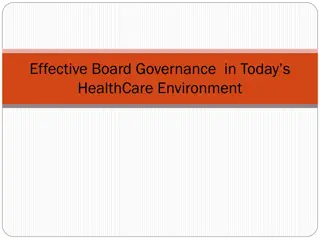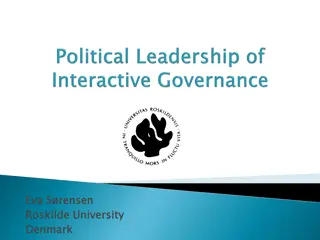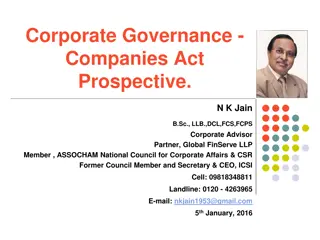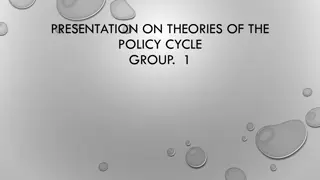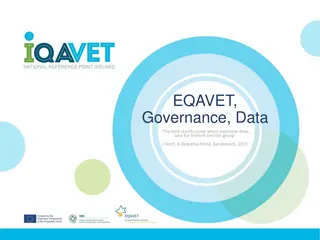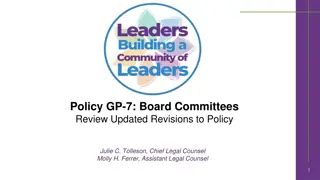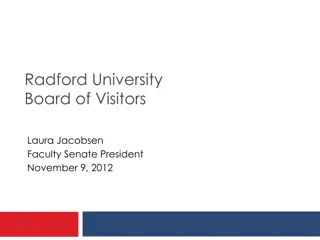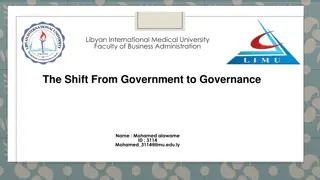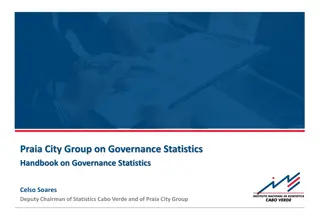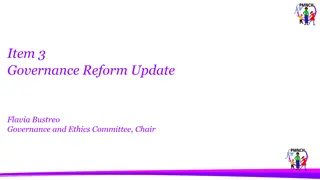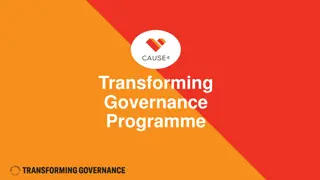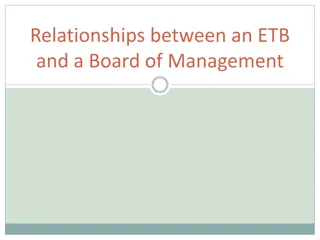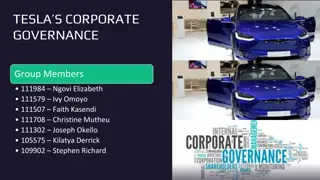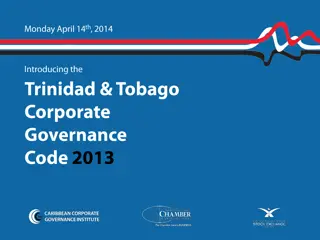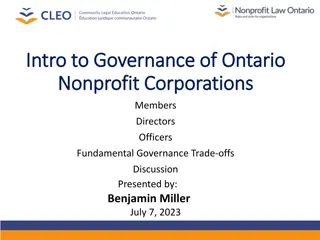Understanding Policy Governance Model for Effective Board Interactions
Exploring the Policy Governance Model which emphasizes the separation of ends and means, creating clarity in responsibilities, and promoting good board governance practices. Attendees will gain insights on overcoming challenges in board interactions and facilitating a shift towards effective and strategic board management.
Download Presentation

Please find below an Image/Link to download the presentation.
The content on the website is provided AS IS for your information and personal use only. It may not be sold, licensed, or shared on other websites without obtaining consent from the author. Download presentation by click this link. If you encounter any issues during the download, it is possible that the publisher has removed the file from their server.
E N D
Presentation Transcript
Phantom of the Board Successful Board Interactions
Northern California Panel Maria Kao, Esq. Berding I Weil LLP Larry Mellberg, CCAM Parkwoods Community Association Rosalia Tapia, Esq. Pratt & Associates
Outcomes At the conclusion of this session, attendees will: Develop a deeper understanding of Policy Governance Learn to overcome the challenge of working with boards who do not stay in their own lane Gain a deeper understanding of how to make boards operate effectively Learn to help boards shift from micromanagers to Big Picture thinkers
What is Governance? The establishment of policies and continuous monitoring of their proper implementation, by the members of the governing body of an organization It includes the mechanisms required to balance the powers of the members (with the associated accountability), and their primary duty of enhancing the prosperity and viability of the organization.
What is a Policy Governance Model? It allows boards to separate ends (purpose) from means (issues) It creates an environment where there is no confusion about: o Who is responsible to the board o The board s expectations regarding their responsibilities
What is a Policy Governance Model? (Cont.) It emphasizes good board governance vs. inserting personal perspectives or agendas into the day-to-day operation of an association. It forces the Board to be policy-driven and not management-driven.
What is a Policy Governance Model? (Cont.) It allows a manager to do the job they were hired to do without getting caught up in the personal perspective or agendas of the individual board members.
What are the components of the Policy Governance Model? Volunteer board of directors and officers o Appointed by the board oHandles the adoption and implementation of major policies and rules oDelegates certain tasks to committees or manager
What are the Components of the Policy Governance Model? (Cont.) Committees o Typically appointed by the Board
What are the Components of the Policy Governance Model? (Cont.) Manager oFocuses on operational tasks oThe management contract should dictate responsibilities along with the policies established by the Board of Directors to ensure a consistent flow in the day to day operations of the community.
Reliance on Experts Duty of Care o Directors are legally obligated and expected to rely on the advice of experts. o Directors must, when prudent, consult with experts & gather information to make informed decisions.
The Manager Serves Three Teams The Board The Membership The Staff
The Board Team Manager needs to establish rapport with the Board. Board needs to fully support manager in front of the membership and staff.
The Membership Team The manager serves the membership under the policies established by the Board. Membership needs to know that the manager reports to the Board not to individual members.
The Staff Team The manager should guide staff by directing them in day-to-day operations, processes & procedures. Staff reports directly to the manager and not to the Board or the residents. Staff assists the manager in the daily service to the membership.
Role of the Board vs. Role of the Manager Make sure everyone has a clear understanding of their role. Set expectations on both sides of the table and set your boundaries early on. Arrange for Board training sessions by industry professionals.
Role of the Board vs. Role of the Manager (Cont.) Together, review the management contract which outlines the manager s duties.
Community Policies Establish a vision or mission statement for the corporation. The Board sets policies by which they want the corporation to be run. The manager operates within those policies to run the day-to-day business of the corporation.
Policy Categories that Support the Corporation Mission Statement Board to Management Delegation End Statements Management Limitations Board Governance Process
A Board that Operates Under Policy Governance Will: Pay greater attention to issues of purpose and direction, making more strategic decisions Empower the manager by delegating what is appropriate while maintaining control of the boundaries within which the manager must act
A Board that Operates Under Policy Governance Will: (Cont.) Allow the manager to make effective decisions, based on his/her knowledge and expertise, to carry out the Board directions
The Difference Between Directing & Micromanaging Webster s dictionary defines a director as one who directs . It is important to establish regular communication lines and expectations early on.
Directing v. Micromanaging (Cont.) Take a pulse, frequently, to see if you are falling short . Collaborate on solutions. Sometimes, all it takes is involvement!
Benefits to Educating the Board on Governance Board now has: o Established priorities o A clear understanding of what is expected o An understanding of the parameters for the Manager to function o Clear ends which makes measuring the performance equally as clear
Getting the Board to Depend on You Establish a good track record in order to get the Board to trust you. Establish good communication (i.e. routine reports, requests for approval, directions). Provide results , i.e., complete the task as required and by the set deadline.
Getting the Board to Depend on You (Cont.) Communication is key keep the board apprised with status updates. Mistakes if you make one, own up to it and rectify it. Be proactive. Look for opportunities to act without being requested.
Getting the Board to Depend on You (Cont.) Develop the relationship Set big and small goals Maintain total transparency Provide reports regularly Under promise, over deliver
Earn Trust through Communication Take the time to seek clarification to ensure you properly interpret the expectations of others Know your audience Ask clarifying questions Repeat your interpretation of what you heard
Forms of Communication that Build Trust Written communication to the Board Weekly FYI Memo Reports in the form of an Executive Summary Written communication to the membership
Forms of Communication that Build Trust (Cont.) Email blasts regarding situations that residents need immediately One-on-one meetings with a member who has a specific concern
Integrity To be viewed as honest and trustworthy, a manager should: oAvoid surprises oFollow through on commitments oRespect limitations oOwn up to mistakes oStrive for transparency
Tips to Support Manager Responsibilities Foster good relationships with industry professionals and business partners Become educated and savvy at using HOA related resources Read HOA related publications and articles
Tips to Support Manager Responsibilities (Cont.) Encourage Board education Communicate regularly and honestly Provide good examples
Board Orientation Can be held onsite or at the HOA attorney or manager s office A Board orientation should include: oTraining session conducted by attorney or manager for new and/or current board members
Board Orientation (Cont.) Consider including sections of time for the CPA, insurance broker and legacy Board Members Consider providing handouts/materials prepared by HOA attorney and/or manager for future reference
Board Orientation Topics Review of Director roles Legal document summary (CC&Rs, Bylaws and Operating Standards) All policies adopted by the Board summarized into a policy manual Explanation of fiduciary responsibility Review of current financial statement
Board Orientation Topics (Cont.) Discussion of confidentiality requirements Explanation of Director protection: immunity and indemnity Review of insurance requirements Identification of any areas that seem to cause issues or are a challenge for a specific Board
Boards Code of Conduct Centered around Breach of Fiduciary Duty : See Cohen v. Kite Hill Sets forth guidelines for Board members regarding ethics, conflict of interest, and Board meeting protocols Describes how the Board will need to conduct itself
Boards Code of Conduct (Cont.) Sets forth possible sanctions for code violations Spell out the procedures & ramifications of what takes place if the code is not followed Requires each board member to sign the code
The Role of the Manager in Developing a Code of Conduct Direct the Board to CACM materials ( Check out CACM Code of Ethics for Managers we could use something like this ) Explain fiduciary duty in the performance of duties Discuss how the code should clearly explain what is expected of each Board member
The Role of the Manager in the Developing a Code of Conduct (Cont.) Demonstrate through examples how it will eliminate gray areas Emphasize the importance of each Board member signing the code
Northern California Panel Maria Kao, Esq. Berding I Weil LLP mkao@berdingweil.com (800) 838-2090 Larry Mellberg, CCAM Parkwoods Community Association larry@collins-mgmt.com (510) 841-2105 Rosalia Tapia, Esq. Pratt & Associates rtapia@prattattorneys.com (408) 369-0800


